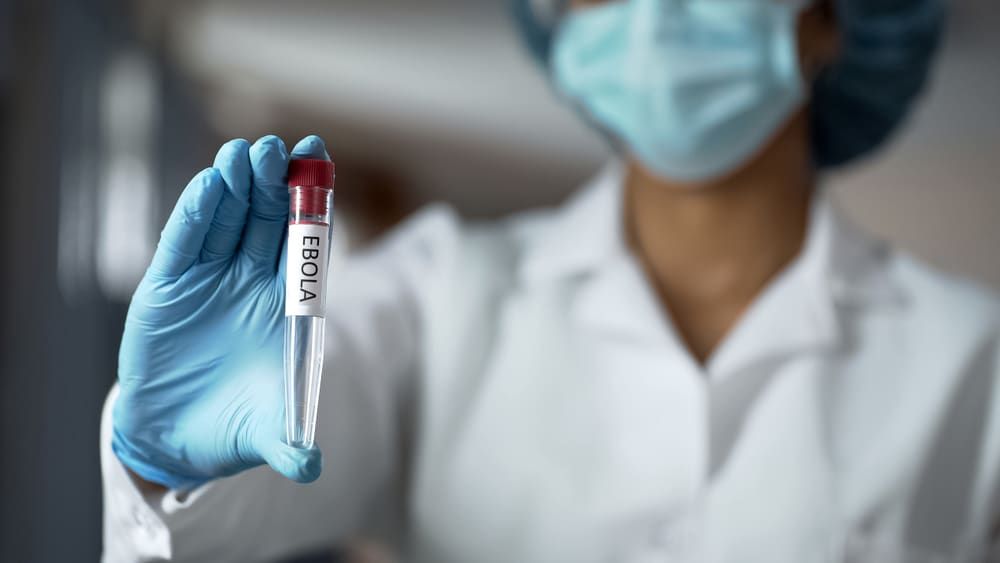Ebola vaccine: What took so long?
By Christopher K. Brown | May 31, 2018

In a typical Ebola outbreak, the fatality rate is often 30 percent or more. Tens of thousands of people have contracted the disease since it was discovered in 1976, with the bulk of the cases recorded during the 2014–2016 West African epidemic. Many calendar years have seen at least a handful of people sickened with this frequently fatal disease. So why is a vaccine just now reaching the public in Africa?
This question is especially pertinent because a new Ebola outbreak is under way in the Democratic Republic of the Congo. More than 50 cases of the disease have been reported so far, including several in Mbandaka, a city of about 1.2 million people. Preventing the spread of the virus from infected individuals to their close contacts, including in densely populated areas and in Ebola treatment centers, is crucial to arresting the outbreak. One critical new tool for controlling the disease is an experimental vaccine against Zaire ebolavirus, the species that causes most human Ebola cases, including those associated with the current outbreak. About 7,500 doses of the vaccine are available, or soon will be, to the public health authorities working feverishly to contain the spread of the disease. The deployment of the vaccine is good news—but again, why has it taken decades for an experimental vaccine to reach the site of an Ebola outbreak?
Vaccine development is a complex process. It involves both public and private partners and requires that a variety of funding issues be considered. Competing market forces influence how a vaccine project advances—from discovery to laboratory and clinical trials, and later to registration, regulatory approval, and large-scale manufacturing and implementation. Is a particular disease a high-enough priority to warrant investment in vaccine development in the first place? Can available technology address the challenges of identifying vaccine candidates? These questions, among others, are germane to almost all vaccine projects—past, present, and future. In the case of forthcoming vaccine candidates for Ebola virus, investment considerations and political realities likely played a significant role in the slow development of a market-ready Ebola vaccine.
Technology: Not the main barrier. Importantly, difficulties in identifying effective vaccine candidates are not the major reason that no licensed Ebola vaccine yet exists. By no means is this to say that vaccine discovery is simple; to the contrary, it’s hard.
Vaccine discovery is the process of identifying a pharmaceutical formulation that can confer immunity to a disease, or at least reduced susceptibility to it, without causing the disease itself or producing too many adverse side effects. Scientists must find a target to work on—for example, a suitable surface protein or piece of genetic code that can trigger an appropriate immune response. They must also identify a viable delivery vehicle, such as a killed or weakened pathogen or a benign organism that can carry the immunity-inducing material into the body. Generally speaking, the technology to achieve these aims is within reach. Dozens of safe, effective vaccines are readily available, especially in the developed world, including for serious diseases such as anthrax and smallpox. Hundreds more projects in vaccine research and development are under way in laboratories around the world.
For Zaire ebolavirus, a potential vaccine has been in existence for about 15 years—but this promising vaccine candidate hasn’t yet been fully vetted through clinical trials and is still not ready for widespread use. Work on a second potential vaccine, conceived a few years before the 2014–2016 epidemic, made it only as far as early clinical trials during the West African crisis a few years ago.
In the early 2000s, a team of scientists at the Public Health Agency of Canada aimed to verify the results of a study involving Ebola’s outer protein and sugar coating—its surface glycoprotein. The scientists devised a method for replacing the glycoprotein of the relatively harmless vesicular stomatitis Indiana virus (VSV) with that of the Zaire ebolavirus. But when the scientists inoculated mice, and eventually macaques, the animals showed immunity to Ebola. The researchers realized that they had inadvertently created a vaccine that could replicate within an animal’s body—that could trigger both humoral and cellular immunity, without resulting in pathogen replication.
Separately, before the 2014–2016 Ebola epidemic, scientists at GlaxoSmithKline—a large British drug company—had begun engineering a chimpanzee adenovirus to produce Ebola virus glycoprotein. That vaccine, known as cAd3-ZEBOV, produces an immune response similar to that of the VSV-based vaccine and causes the body to recognize and resist Ebola virus infection.
Within a couple of years of the discovery of the VSV-based vaccine (known as rVSV-EBOV), Canada licensed it to BioProtection Systems, a subsidiary of US biopharmaceutical company NewLink Genetics Corporation. But the vaccine made little progress toward the market—at least until 2014, when the West African Ebola outbreak reinvigorated the effort. In that year, NewLink entered into an agreement with drug giant Merck to manufacture and distribute the rVSV-EBOV vaccine—which is being used to contain the current Ebola outbreak. Since its reboot, the VSV-based vaccine has continued to advance toward readiness for widespread use: Phase III clinical trial data have shown that it offers “substantial protection” against Ebola.
Meanwhile, as new cases in the 2014–2016 West African epidemic subsided, so did work on the cAd3-ZEBOV option. According to the National Institute of Allergy and Infectious Diseases, the decline in Ebola cases made it impossible to carry out the large studies that were originally planned as part of phase III trials.
Return on investment? The slowdown of the 2014–2016 epidemic, however, doesn’t fully explain why work on possible Ebola vaccines has sometimes stalled, or failed to start. Another issue is the perception, if not the real risk, that drug companies will earn a small return on their investments in markets where vaccines are needed most. With minor exceptions in the United States, Italy, and Spain during the epidemic earlier this decade, natural transmission of Zaire ebolavirus has occurred almost exclusively in Africa. (Twice, Russian researchers have been infected while working with the virus in laboratories.) Yet nations such as the Democratic Republic of the Congo, Liberia, and Guinea—the countries with the greatest number of total Ebola cases—have limited ability to purchase vaccines, much less contribute to the hundreds of millions of dollars required to bring a new vaccine to market. As it stands, funding for research and development comes mostly from governmental agencies in the United States, Canada, the United Kingdom, Switzerland, and EU nations, as well as from multinational organizations supported by those countries. In developed countries, nongovernmental organizations such as the Bill and Melinda Gates Foundation and the Rockefeller Foundation also support vaccine research and development.
Many of the biggest drug companies are based in the same nations that provide the greatest support for research and development. Indeed, once an effective vaccine candidate is identified, a key factor in advancing it to market is identifying corporate partners with the resources to fund animal studies and clinical trials, as well as the manufacturing capability to produce the vaccine in large quantities. Only a limited number of large drug companies—or, in some cases, partnerships between drug companies and smaller biotechnology firms—have such resources. These firms can only support the development processes—especially during the research and development phase—of a limited number of vaccines at one time.
When a vaccine is ready for production and delivery, there must be customers to buy it. Historically, heavy government investment—including large purchases for emergency stockpiles—has enabled production of vaccines for rare diseases. The anthrax vaccine BioThrax, for example, has been propped up largely by funding from the US government, which purchases millions of doses for the Strategic National Stockpile. In 2016, the Centers for Disease Control and Prevention signed a contract worth almost $1 billion with Emergent BioSolutions to deliver more than 29 million doses of the vaccine through 2021. Another contract, awarded by the Biomedical Advanced Research and Development Authority, added $100 million in support for the BioThrax manufacturer. But Ebola virus—compared to Bacillus anthracis, the bacterium that causes anthrax—is not as easily stabilized (or weaponized) for environmental dissemination, such as might be accomplished over a wide area through use of an aerosol. Thus nations are much less likely to stockpile countermeasures against Ebola than against anthrax, especially if they lie outside Africa, where the Ebola virus is endemic.
These resource limitations force prioritization of diseases: Which ones warrant the resources required to produce an effective vaccine? When the funders of research and development efforts spend taxpayer dollars, a vaccine’s benefit to those taxpayers certainly factors into the decision-making process. Government agencies may be less apt to support development of vaccines for Ebola than, for example, influenza, which sickens and kills many thousands more people at home each year than Ebola kills abroad. In the United States, the Centers for Disease Control and Prevention estimates that 9 to 36 million cases of flu occur annually, resulting in 12,000 to 56,000 deaths each year. In most years, there are no Ebola cases in the United States; excluding medical evacuations to US hospitals, only four cases were reported in the United States during the 2014–2016 West Africa epidemic. Even with this vast difference in disease-specific morbidity and mortality, there is still no universal influenza vaccine; the formulation must be changed each year based on epidemiological forecasts of which viruses are likely to circulate during flu season. Is it a smart investment for the United States to pour half a billion dollars into an Ebola vaccine when so many of its own people are infected with influenza viruses each year?
Even comparing Ebola to other diseases that disproportionately affect African countries, it is hard to argue that Ebola is, or ever has been, the best disease on which to focus vaccine research and development resources. Malaria, a febrile illness caused by parasites and spread by mosquito bites, is a vivid example. Most years witness only isolated Ebola outbreaks in Africa, in which a handful of people are infected and killed, but malaria kills close to half a million people each year, with at least four times that number experiencing non-fatal infections. Africa bears 90 percent of that burden. Although a malaria vaccine exists, it is only effective up to about 50 percent of the time. HIV/AIDS also kills many hundreds of thousands more people in Africa each year than does Ebola. The World Health Organization estimates that three in four people who die from HIV-related causes are African, with about 800,000 HIV/AIDS–attributable deaths occurring on the continent each year. Although access to antiretroviral therapies and pre-exposure prophylactics is improving, no approved vaccine exists. Potential HIV vaccines are undergoing clinical trials, but early results show somewhat limited effectiveness. Additional research is needed to support development of more protective vaccine formulations for malaria, HIV, and other diseases—formulations important for safeguarding vulnerable populations from infections much more rampant than Ebola.
Time to reevaluate. An effective Ebola vaccine, despite the stop-and-go nature of its development, is now helping control the outbreak in the Democratic Republic of the Congo. Under World Health Organization and national emergency-use approvals, public health and other aid workers are conducting a ring vaccination campaign, tracing back infected patients’ contacts to vaccinate them and, in some cases, their contacts. Certain other individuals, such as health care workers, can also get the vaccine. Beyond the 7,500 doses of vaccine that the World Health Organization has deployed, a partnership called Gavi, The Vaccine Alliance, has agreed to buy, as needed, 300,000 more investigational doses of the vaccine for use in the Democratic Republic of the Congo. Gavi also plans to purchase the rVSV-EBOV vaccine and make it available for combatting future outbreaks once it is formally approved. Much of the work to support that approval is complete—as mentioned, the rVSV-EBOV vaccine has shown success in phase III trials. Additional vaccine candidates, including several not mentioned in this article, are at various stages of research and development, and may be viable options for controlling future outbreaks.
The illnesses and deaths associated with the current Ebola outbreak, and potentially with the 2014–2016 epidemic, might have been prevented if a vaccine for the disease had been deployed sooner. After all, a promising vaccine candidate had been discovered years earlier. Today’s approach to vaccine discovery—market-driven, just-in-time—is inherently problematic, as the current Ebola outbreak highlights. It is time to re-examine how resources are allocated for research into and development of medical countermeasures.
Editor’s note: This article was written in the author’s personal capacity. The opinions expressed here are his own and do not necessarily reflect those of his employer or any other US government agency.
Editor’s note: Sonia Ben Ouagrham-Gormley, associate professor at the Schar School of Policy and Government at George Mason University, contributed to this article.
Together, we make the world safer.
The Bulletin elevates expert voices above the noise. But as an independent nonprofit organization, our operations depend on the support of readers like you. Help us continue to deliver quality journalism that holds leaders accountable. Your support of our work at any level is important. In return, we promise our coverage will be understandable, influential, vigilant, solution-oriented, and fair-minded. Together we can make a difference.
Topics: Uncategorized















